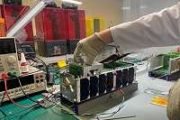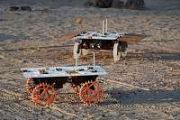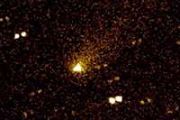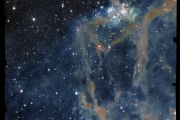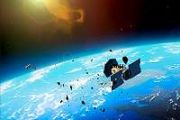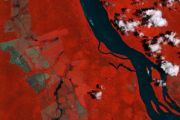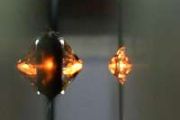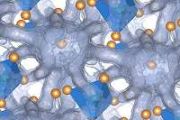
Copernical Team
NASA Opens Submissions for 2025 Human Lander Challenge Targeting Cryogenic Solutions
 NASA's Human Lander Challenge (HuLC) is now accepting submissions for its second year. As part of NASA's Artemis campaign, which aims to return astronauts to the Moon and prepare for future Mars missions, the agency is seeking innovative ideas from college and university students. This year, the focus is on developing cryogenic propellant technologies for human landing systems.
For the 202
NASA's Human Lander Challenge (HuLC) is now accepting submissions for its second year. As part of NASA's Artemis campaign, which aims to return astronauts to the Moon and prepare for future Mars missions, the agency is seeking innovative ideas from college and university students. This year, the focus is on developing cryogenic propellant technologies for human landing systems.
For the 202 Maritime Launch Services Partners with Global Launch Vehicle Developer for Orbital Launches at Spaceport Nova Scotia
 Maritime Launch Services Inc. (Cboe CA: MAXQ, OTCQB: MAXQF) has signed a Memorandum of Understanding (MOU) with a leading international launch vehicle operator to initiate the deployment of a small-class orbital vehicle from Spaceport Nova Scotia.
This MOU is a pivotal development for Canada's growing role in global space activities, enhancing Spaceport Nova Scotia's position as a premier
Maritime Launch Services Inc. (Cboe CA: MAXQ, OTCQB: MAXQF) has signed a Memorandum of Understanding (MOU) with a leading international launch vehicle operator to initiate the deployment of a small-class orbital vehicle from Spaceport Nova Scotia.
This MOU is a pivotal development for Canada's growing role in global space activities, enhancing Spaceport Nova Scotia's position as a premier New Interactive TEMPO Data Story Offers Public Access to Air Quality Information
 NASA and the Center for Astrophysics | Harvard and Smithsonian have announced the public availability of "high-quality, near real-time air quality data" from NASA's TEMPO (Tropospheric Emissions: Monitoring of Pollution) mission. Launched on May 30, 2024, this data release is part of an ongoing effort to enhance public understanding of air quality. The NASA Science Activation program's Cosmic Da
NASA and the Center for Astrophysics | Harvard and Smithsonian have announced the public availability of "high-quality, near real-time air quality data" from NASA's TEMPO (Tropospheric Emissions: Monitoring of Pollution) mission. Launched on May 30, 2024, this data release is part of an ongoing effort to enhance public understanding of air quality. The NASA Science Activation program's Cosmic Da Viasat Enhances L-TAC Satellite Service with On-Demand Features
 Viasat, Inc. (NASDAQ: VSAT), a global leader in satellite communications, has introduced the next phase of its L-band tactical satellite service, L-TAC, offering new capabilities that allow users to access the service on-demand when and where needed. The L-TAC service, facilitated through Viasat's extensive L-band network, connects radio users and command centers across the globe by utilizing ta
Viasat, Inc. (NASDAQ: VSAT), a global leader in satellite communications, has introduced the next phase of its L-band tactical satellite service, L-TAC, offering new capabilities that allow users to access the service on-demand when and where needed. The L-TAC service, facilitated through Viasat's extensive L-band network, connects radio users and command centers across the globe by utilizing ta Cosmic Ray Data from AMS Reveals Unexpected Deuteron Surplus
 Scientists analyzing data from the Alpha Magnetic Spectrometer (AMS) aboard the International Space Station have encountered an unexpected abundance of cosmic rays composed of deuterons - atomic nuclei containing a proton and a neutron. This surprising discovery adds to the growing list of unanticipated findings from AMS, which has been operational since 2011 and has detected over 238 billion co
Scientists analyzing data from the Alpha Magnetic Spectrometer (AMS) aboard the International Space Station have encountered an unexpected abundance of cosmic rays composed of deuterons - atomic nuclei containing a proton and a neutron. This surprising discovery adds to the growing list of unanticipated findings from AMS, which has been operational since 2011 and has detected over 238 billion co Researchers Develop Advanced Silicon Photonic Chip for GPS-Free Navigation
NASA's Cold Atom Lab Uses Quantum Sensor for First Time in Space
 NASA's Cold Atom Lab, an innovative facility aboard the International Space Station (ISS), has made a significant advancement by using ultra-cold atoms to detect environmental changes in space. For the first time, the lab measured the International Space Station's subtle vibrations, showcasing the potential of quantum science in space applications.
The recent study, published in 'Nature Co
NASA's Cold Atom Lab, an innovative facility aboard the International Space Station (ISS), has made a significant advancement by using ultra-cold atoms to detect environmental changes in space. For the first time, the lab measured the International Space Station's subtle vibrations, showcasing the potential of quantum science in space applications.
The recent study, published in 'Nature Co Autonomous mini robot captures historic photo on Lunar Far Side
 A stunning image recently released by the China National Space Administration has captivated audiences, showing the desolate landscape of the far side of the moon. The photograph, taken after China's Chang'e 6 probe collected lunar samples in June, quickly went viral across Chinese social media, sparking widespread curiosity about the photographer behind the lens.
Chinese space engineers h
A stunning image recently released by the China National Space Administration has captivated audiences, showing the desolate landscape of the far side of the moon. The photograph, taken after China's Chang'e 6 probe collected lunar samples in June, quickly went viral across Chinese social media, sparking widespread curiosity about the photographer behind the lens.
Chinese space engineers h China Implements Mitigation Measures Following Long March 6A Rocket Breakup
 China has initiated necessary measures and is closely observing the affected orbital area following the breakup of a Chinese rocket, according to a statement by Foreign Ministry spokesman Lin Jian on Wednesday.
Reports indicate that a Long March 6A rocket, which was launched from the Taiyuan Satellite Launch Center on August 6, disintegrated in low-Earth orbit last week, creating a debris
China has initiated necessary measures and is closely observing the affected orbital area following the breakup of a Chinese rocket, according to a statement by Foreign Ministry spokesman Lin Jian on Wednesday.
Reports indicate that a Long March 6A rocket, which was launched from the Taiyuan Satellite Launch Center on August 6, disintegrated in low-Earth orbit last week, creating a debris Researchers Unveil Insights into Quark Matter in Neutron-Star Collisions
 Collisions between neutron stars likely produce the densest form of matter known in the Universe. Through innovative approaches using two theoretical methods, scientists have now gained deeper insights into the behavior of quark matter under the extreme conditions created during these cosmic events.
Neutron stars, remnants of old stars that have exhausted their nuclear fuel and collapsed a
Collisions between neutron stars likely produce the densest form of matter known in the Universe. Through innovative approaches using two theoretical methods, scientists have now gained deeper insights into the behavior of quark matter under the extreme conditions created during these cosmic events.
Neutron stars, remnants of old stars that have exhausted their nuclear fuel and collapsed a 
